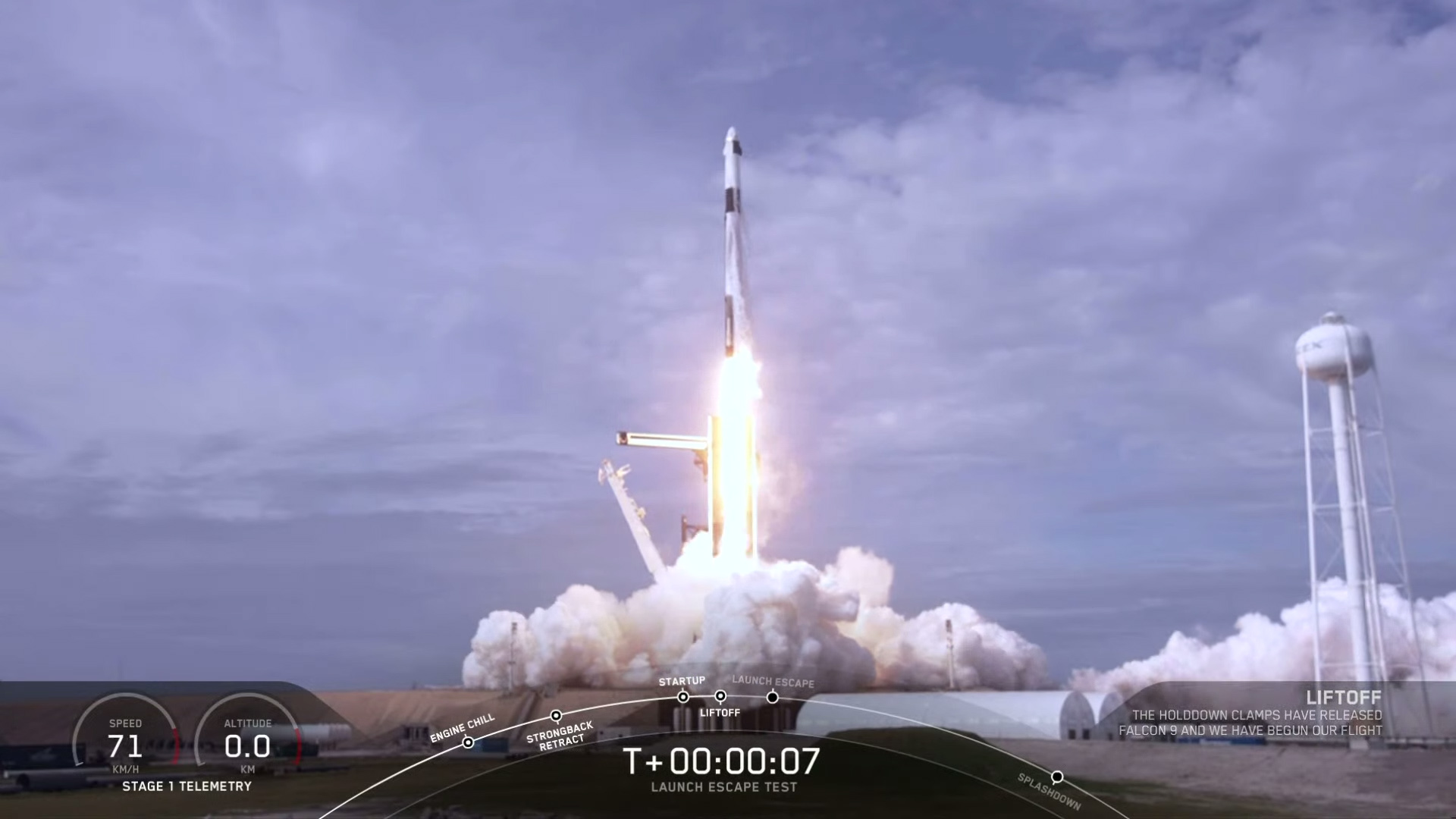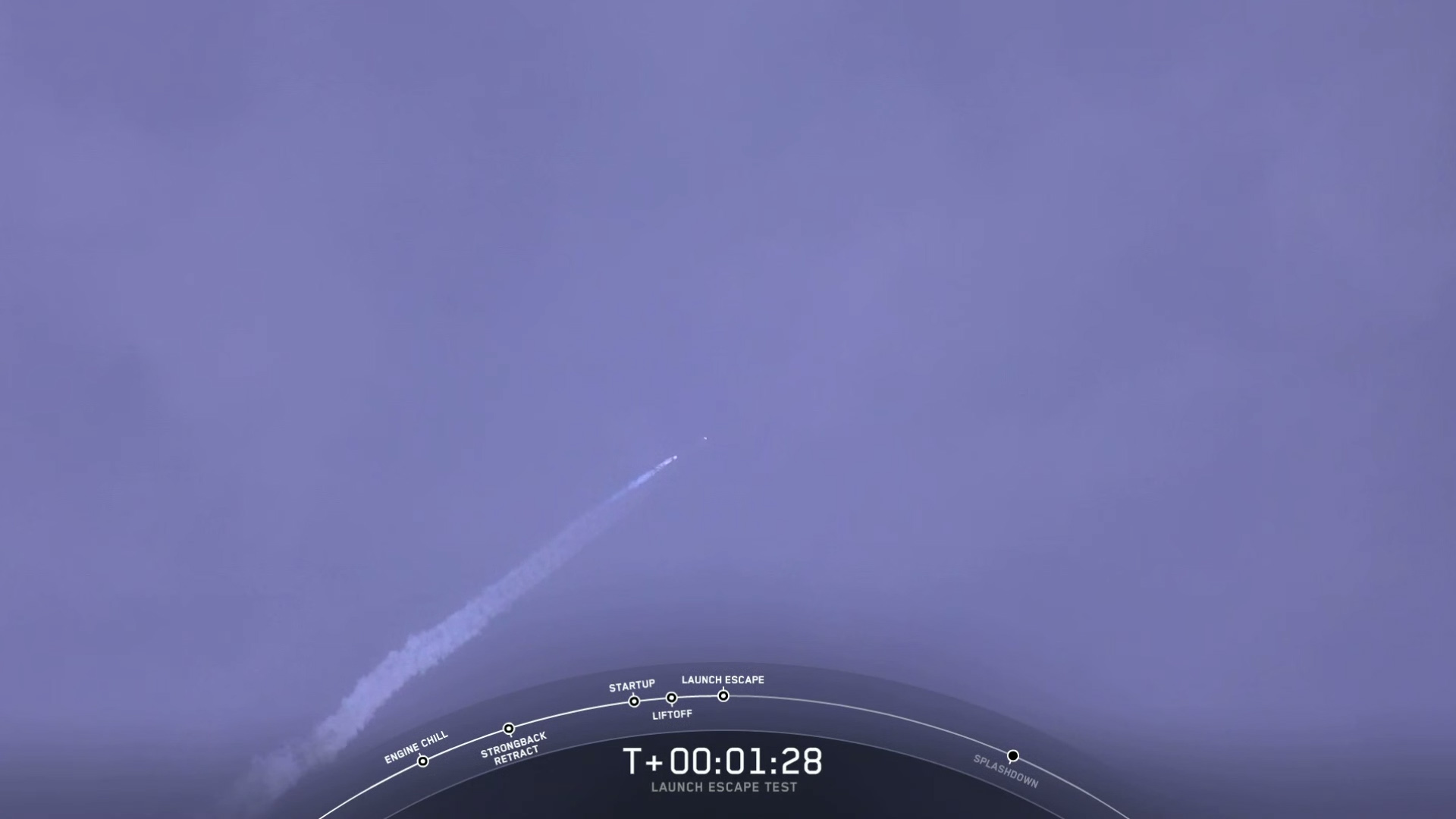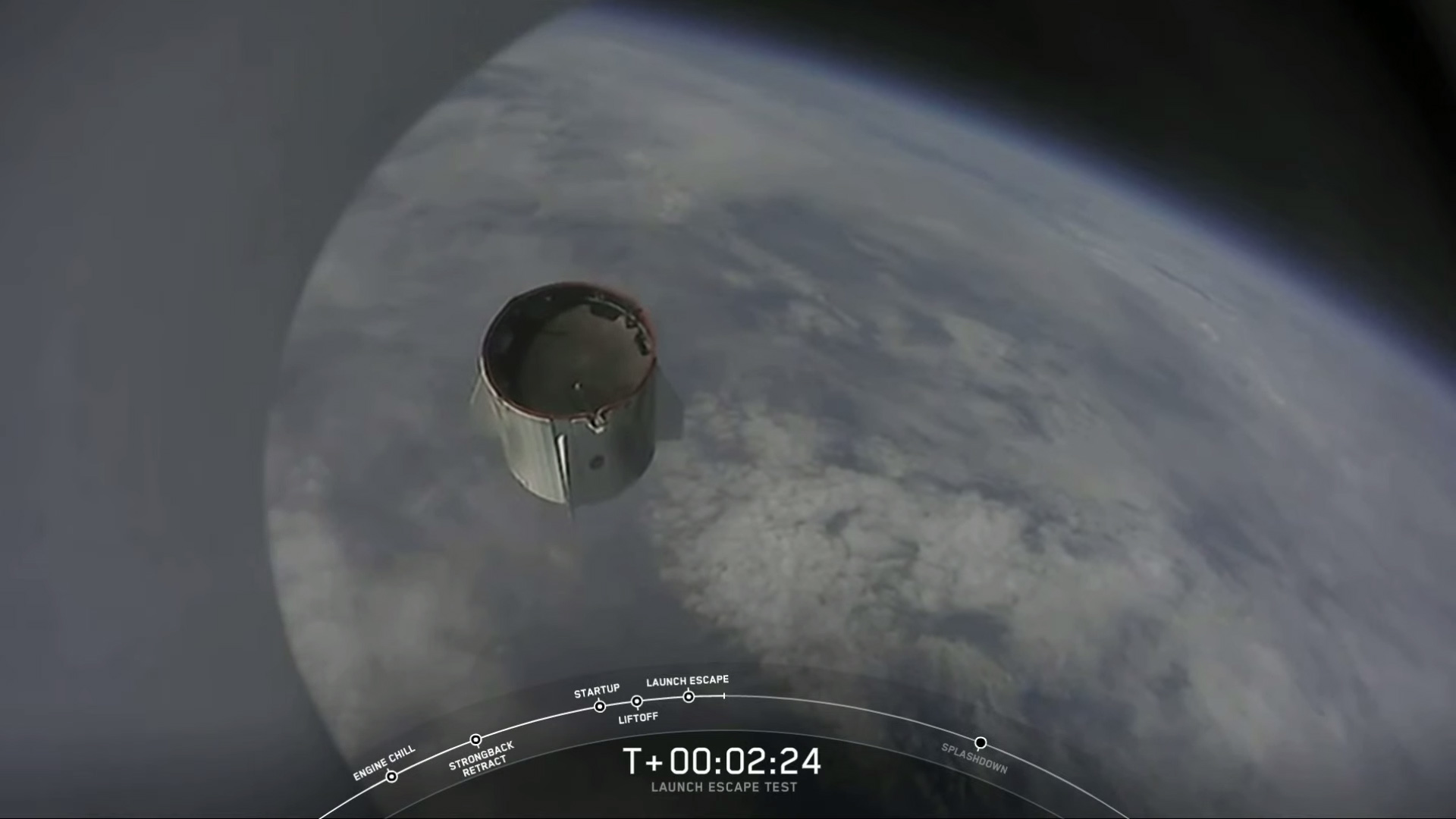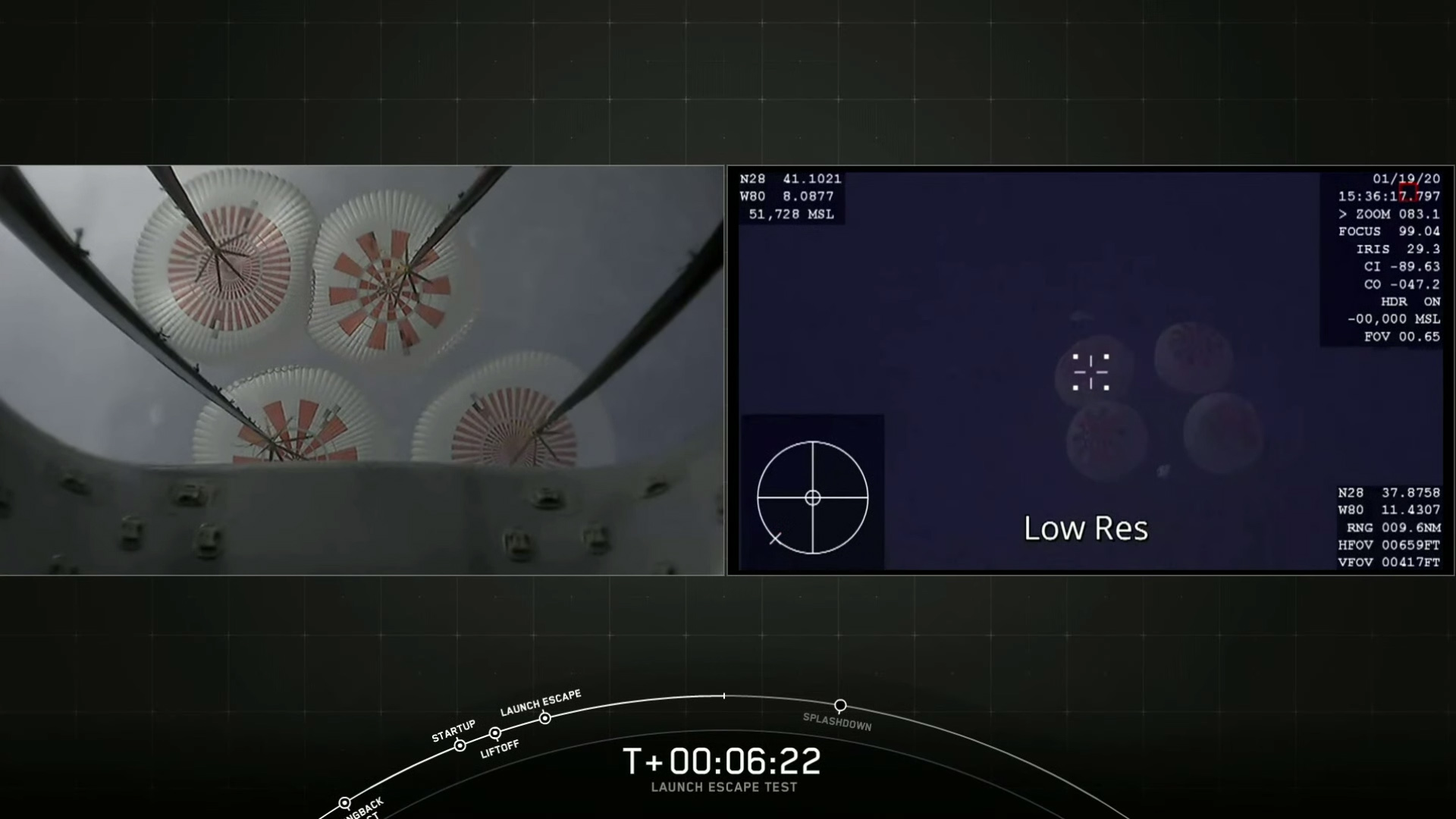SpaceX aces Crew Dragon launch abort test, destroys rocket on purpose
CAPE CANAVERAL, Fla. — SpaceX just took a giant leap forward in its quest to launch astronauts. The private spaceflight company intentionally destroyed one of its rockets on Sunday (Jan. 19) as part of a crucial test of its new Crew Dragon capsule's launch escape system.
The uncrewed test, known as an in-flight abort (IFA) test, is the last major hurdle SpaceX needed to clear before Crew Dragon can begin to carry astronauts to and from the International Space Station (ISS). Originally scheduled to launch on Saturday (Jan. 18), the unpiloted crew capsule was grounded for 24 hours due to unfavorable weather conditions at both the launch site and the Crew Dragon recovery zone, the Atlantic Ocean just off the Florida coast.
The weather forecast on Sunday looked equally ominous, with the chances of favorable conditions at liftoff worsening. However, the weather cleared and SpaceX was able to lift off at 10:30 a.m. EST (1530 GMT).
Video: Watch SpaceX destroy a Falcon 9 in Crew Dragon abort
Related: How SpaceX's Crew Dragon capsule works (infographic)

A SpaceX Falcon 9 rocket launches the Crew Dragon spacecraft on a major abort system test on Jan. 19, 2020 from Pad 39A of the Kennedy Space Center in Cape Canaveral, Florida.

The Falcon 9 rocket used to launch Crew Dragon's abort test made its fourth flight for this mission. It did not survive, and that was expected.

Here, SpaceX's Crew Dragon can be seen just after igniting its abort engine burn. Eight SuperDraco engines fired to rip the spacecraft free of its Falcon 9 rocket.

The Falcon 9 rocket, fully fueled for launch, appears to explode and break apart after Crew Dragon's abort maneuver. This was expected and SpaceX warned viewers to expect the rocket's fiery fate.

Crew Dragon's "trunk" is seen here after separating from the crew capsule section. Crew Dragon was expected to reach a maximum altitude of about 25 miles (40 kilometers) during the launch.

The four Mark 3 main parachutes deploy to slow Crew Dragon during its descent back to Earth. The spacecraft splashed down in the Atlantic Ocean about 20 miles (32 kilometers) east of the launch site.
Excited onlookers anxiously awaited the test, their cameras poised in a grassy area at the NASA press site. The Falcon 9 roared to life, triggering car alarms and shaking nearby buildings. After the planned launch abort was triggered, 84 seconds into the flight, a fireball was spotted in the sky.
A few moments later, a sonic boom echoed through the sky. The Falcon 9 exploded as expected, and a second boom was heard when its remnants hit the ocean. Onlookers were hoping to see Crew Dragon descend under parachute, but unfortunately clouds obstructed much of the view.
A vital test
The mission starred an unpiloted crew capsule that blasted off from NASA's Kennedy Space Center here in Florida atop a Falcon 9 rocket with a thrice-flown first stage. Before meeting its demise today, this booster made three trips to space in 2018, lofting the first Bangladeshi satellite; an Indonesian communications satellite; and then an epic rideshare mission that launched a stack of 64 satellites.
Breaking space news, the latest updates on rocket launches, skywatching events and more!
The booster was the first of SpaceX’s upgraded "Block 5" Falcon 9 rockets to fly and, after serving the company well, it went out with a bang today, destroyed by Dragon fire.
The IFA mission was designed to test Crew Dragon's SuperDraco-powered abort system, which will pull the capsule free of its launcher in the event of an emergency during flight.
“We are purposefully failing a launch vehicle, to make sure our abort system works,” Kathy Lueders, NASA’s Commercial Crew Program manager, said during a prelaunch news briefing on Friday (Jan. 17). “That’s a very, very different way for us to formally conduct a mission.”
Related: See the Evolution of SpaceX's Rockets in Pictures
When NASA retired its fleet of space shuttles in 2011, the agency looked to the commercial sector to ferry crews to and from the ISS, selecting SpaceX and Boeing as its future space taxi providers. Each of these two companies has built a spacecraft capable of safely carrying crew under a series of contracts, the most recent two of which, announced in September 2014, are worth a total of $6.8 billion. Once operational, the two vehicles — SpaceX's Crew Dragon and Boeing's CST-100 Starliner — will be NASA's primary means of transporting astronauts to and from space.
SpaceX launched its first Crew Dragon mission, an unpiloted test flight to the station, in March 2019. Crew Dragon's in-flight abort test was delayed when that same capsule exploded during a ground test last April, forcing months of investigation, upgrades and a series of successful static-fire tests to make way for this weekend's launch.
In 2019, Boeing also launched a pad abort test of its own Starliner spacecraft, as well as an unpiloted test flight to orbit. That orbital flight test, however, did not reach the space station as planned due to a mission clock software error.
Despite these hurdles, both SpaceX and Boeing aim to launch their first crewed missions later this year. But before that can happen, both companies must prove their vehicles have what it takes to keep astronauts safe during flight.
Related: Emergency Launch Abort Systems of SpaceX and Boeing Explained
In-flight anomalies are rare, but they do happen, as we saw in October 2018. Back then, NASA astronaut Nick Hague and Russian cosmonaut Alexey Ovchinin were on their way to the space station when their launcher — a Russian Soyuz — experienced an in-flight anomaly. The duo were carried to safety by the Soyuz abort system. NASA wants to ensure that, if one of SpaceX's Falcon 9 rockets were to have a similar anomaly, its astronauts would still be brought home safely; this is what the in-flight abort test is all about.
“For this test, Falcon 9’s ascent trajectory will mimic a Crew Dragon mission to the International Space Station to best match the physical environments the rocket and spacecraft will encounter during a normal ascent,” SpaceX said in a mission statement.
However, unlike a normal flight, SpaceX programed its Crew Dragon to intentionally trigger a launch escape shortly after "max Q" — the moment of maximum aerodynamic stress on the rocket.
Embedded within the outer hull of the Dragon capsule are eight engines called SuperDracos. If the vehicle's computer senses that something is amiss during flight, it will trigger these thrusters to fire. Then, the SuperDracos will push the Crew Dragon up and away from the rocket. Once the capsule is at a safe distance from the troubled rocket, the Crew Dragon will deploy its parachutes and land in the Atlantic Ocean, where recovery vessels will retrieve the capsule and the crew.
That's exactly what happened during today's test. The capsule blasted free of its rocket ride less than 90 seconds after liftoff. Less than 5 minutes in, Crew Dragon deployed its drogue parachutes, and the four main chutes followed shortly thereafter. The capsule splashed down softly about 20 miles (30 kilometers) off the Florida coast 9 minutes after launch.
Though much analysis will follow, everything seemed to go exactly as planned today.
"It looks like, right now, a great test," SpaceX principal integration engineer John Insprucker said during the company's live webcast, just after splashdown.
No one was on board the Crew Dragon during the IFA, but SpaceX is treating the drill as if it were an actual emergency. To that end, SpaceX outfitted one of its boats with a helicopter landing pad designed to facilitate the recovery of the Crew Dragon during nominal and emergency landings alike.
Related: How Risky Spacecraft Launch Aborts Work (Infographic)
This test was the last major hurdle that SpaceX must clear before it can launch astronauts. As such, both NASA and SpaceX are paying close attention to the IFA and all the data it returns.
“This is a big test for us,” Benji Reed, SpaceX's director of crew mission management, said prior to launch. “It is a test of the system that is supposed to test the crews and is a very important step in us making progress toward crew transportation to the space station.”
After a data review, SpaceX hopes that NASA will clear Crew Dragon to carry humans. Once that happens, SpaceX will fly two NASA astronauts, Bob Behnken and Doug Hurley, to the space station for a two-week stay during a test mission called Demo-2.
If that initial crew flight goes smoothly, NASA will greenlight Dragon to begin regular crewed flights.
- SpaceX's Crew Dragon Demo-1 test flight in pictures
- Watch how SpaceX's Crew Dragon will launch astronauts into space (video)
- In photos: A behind-the-scenes look at SpaceX's Crew Dragon spaceship
Follow us on Twitter @Spacedotcom or on Facebook.


Amy Thompson is a Florida-based space and science journalist, who joined Space.com as a contributing writer in 2015. She's passionate about all things space and is a huge science and science-fiction geek. Star Wars is her favorite fandom, with that sassy little droid, R2D2 being her favorite. She studied science at the University of Florida, earning a degree in microbiology. Her work has also been published in Newsweek, VICE, Smithsonian, and many more. Now she chases rockets, writing about launches, commercial space, space station science, and everything in between.
